The Proliferation of Dark, Gloomy and Empty Ships in Star Trek
by Finntrekkie
What follows is a slightly tongue-in-cheek look at one of Star Trek's most popular tropes, and an easy, convenient way to ramp up the tension and add some extra visual appeal to a scene - just turn off the lights! If you rather not do that, just make sure that everyone is gone...somewhere, and you are left alone to fend for yourself. You might see where that is going at. This article will look at the various examples and versions of the trope of the haunted ship in Star Trek, and also includes an illustrate gallery of all the examples I could think of.
Why Dark is Scary in Space
Who Turned Off the Lights?
Fear of the dark is probably an innate sense of dread built into us on the biological level. Human beings operate on vision for a great part, and being unable to see gives a natural sense of dread and danger, even if one knows on an intellectual level that you are in a safe place and nothing dangerous is lurking in the darkness, just out of touch. Human night vision is rather poor and is limited to shape vision, giving us a lacking sense of scale, distance and a loss of color perception too due to the physiological function of the eye. Any threats might be much nearer than we might know for starters, which puts us in extra danger. It is likely this fear of the unknown - which is a huge part of the mystery of space and space travel as well - that gives us the dread of the darkness. Moviemakers love to exploit that, of course, and not only in Star Trek.The Visual Appeal of the Dark
Darkness is not only useful as a way to create tension by suggesting monsters are lurking in it, right outside your field of view. With the general lighting level low, interesting ambience can be created with spot lighting that highlights characters or crew. These can be used as visual cues in storytelling besides just trying to make things more interesting to look at. The interplay of darkness and light can have a symbolic value as well. Things may be hidden in the dark, and then other cues, such as sounds, suggest interesting things happening soon.
Let's also be frank. Darkness can also save money. A dark set does not need to be nearly as elaborate as something you need to show in its fully lit glory. The darkness can cover things the production team does not want the viewer to see - although sometimes they slip, with silly results. Darkness, with a few other visual clues, can enlarge the space to be as big as the viewer can imagine. It is an interplay of suggestion, and perception.
Light in Darkness aka how Movie Darkness isn't all that dark after all
The innate problem with darkness is that you can't see anything in it. Although this may be the point being created, to give a more adventurous, tense, exciting feel to the scene, being unable to see the actual actors and their surroundings is counterintuitive. You want things to appear dark without being too dark. You still need to have enough light to see the action, even if it's meant to be pitch black in there. Any portable light sources such as the famous palm beacons seen throughout Star Trek are also an issue, since their light beams have to be taken into account. Sometimes this is added in post-production for better control, too. Movie darkness is usually created with indirect lighting, using particular filters, low-power set lighting pieces and various methods to disperse the light to create a suitable ambience for filming.
Technical limitations are another thing that makes a careful control of the darkness important. Both photographic film and the CCD sensors used by digital camera equipment have limitations to the light sensitivity they provide. Using too little light can cause for the imagine to become very grainy and of low quality. Even with all post-production trickery available to the modern cinematographer, it all begins from properly lighting the set and the actors. The same applies to the special effects photography of the actual ship models. It's dark in space, but you have to be able to see the actual spacecraft.
Dark Means Business
The same way the flashing indicator lights of Red Alert tells us that the ship is heading into danger, turning off the overhead lights suggests urgency. While on a present day warship, the lowered light level is conductive both to improved night vision that might be needed and to make it easier to read computer and other displays, on the spaceship it probably serves some less obvious purpose. "Yesterday's Enterprise" is a good example, showing the Enterprise-D in its combat configuration, with a persistent dark lighting scheme.Dark Means Danger - a power cut in space
Our highly technological lifestyle has made us wholly depending on electricity as a way of running our society. It heats our homes, cooks the food, runs our computers, and keeps the lights on. Even a brief power cut can give a sense of dread and make one wonder on just how long such an unusual state might continue. Artificial lighting is integral to our function, and the people in Star Trek are no exception. Just like in any other visual medium, the sight of a flickering lightbulb - whether figuratively, or literally so - is a sign of something threatening the infrastructure, the very basics of survival at hand. The lights going on and off is a traditional sign of a starship receiving damage from weapons fire or spatial phenomena. It suggests the immense disturbing power of whatever affecting the ship that it can cause the lights - an essential system - to either flicker or actually fail completely. If darkness or near-darkness prevails, the situation must be rather grave. As such, the flickering light is as equally strong a visual cue as sparks, falling debris or even the crew shaking about due to the impact. It is also easy to implement, which makes it all that more attractive.
Damage Control
While flickering lights suggests the ship receiving damage, a persistent darkness afterwards or the use of dim or oddly colored emergency lighting suggests that the ship is now under duress and other kinds of danger awaits as a result of being damaged. Many examples are found throughout the series and the movies, notably the likes of "The Wrath of Khan", "The Year of Hell" and TNG's "Disaster".
Out of Power
Occasionally the darkness has been suggested to be a result of a lack or a loss of power. Voyager had several episodes where the ship had to conserve their power reserves, and turning off the lights was one way to do that. "Night" and "The Void" were built around this premise.
It Feels so Empty
The Evacuation
One of the least sinister ways of producing a suitably deserted starship for exploration by a confused crew member is to simply voluntarily empty the ship. Many Star Trek ships have been evacuated routinely over the years, whether on purpose for planned maintenance work such as in "Starship Mine", or due to a perceived emergency such as in "11001001" where the Bynars enact a fake warp core breach in order to scare the crew to abandon ship. Voyager's "Workforce", "Year of Hell" and "One" all included extensive sequences on the ship being empty and usually dark after the crew vacated the ship - or in the case of "One" and the similarly themed "Doctor's Orders" from Enterprise, in protected quarters. It appears that something odd is bound to happen if you have to be the only one left on the ship.
No Place Like Home - dream and imaginary copies
Our crewmen have often found themselves on a dreamy copy of their assigned ship, whether knowingly or not. Various causes have given forth to these imaginary versions of familiar ships. Whether it's a psychic attack, such as in the case of Bashir in "Distant Voices", a defense mechanism against such telepathic tampering (Deanna encountering an angry wolf and her late father inside her mother's mind in "Dark Page") or being stuck in-between worlds, our people often find themselves in a familiar location, usually with some oddities thrown in. The Prophets of the wormhole, for example, did this a lot, although a strange color scheme gave one an instant feeling of being somewhere not quite right. A recent example is the Prime Stamets and Mirror Stamets meeting in an odd recreation of the Discovery's engine room while both were trapped in the mycelial network.
Another popular way to show us an odd version of familiar locations in the various series is the dream sequence.
The worst offender is Data of all people, who must have the most boring dreams of anyone ever on Star Trek. While Data was originally unable to experience dreaming, an energy discharge caused his dormant dreaming abilities to surface. This made up for a subplot in the double episode "Birthright", where several dream sequences portrayed the strangeness of Data's positronic subconsciousness. The android dreamed of the Enterprise, rather conveniently so, although the use of particular camera angles and lighting created unusual imagery from the familiar areas of the ship, giving it a characteristic look.
What to make of all this? Do our characters love their jobs so much that even their dreams are filled with images of their workplace? Or do the writers suffer from lack of imagination? Perhaps not. It's most likely due to time and money constraints. Dreams are fantastic, after all, but budgets aren't.
Loneliness Kills
While most of the iterations of the Empty Ship trope decisively ramp up the spook factor by making the ship both dark AND empty, the mere lack of people onboard is in itself disorienting and suggestive of things about to go terribly wrong, or having already gone so, resulting in the crew's disappearance. A starship is a closed society, a limited number of people in limited quarters. While the larger size of ships has made them more comfortable in terms of space available for each occupant, many ships do keep their crew is tight proximity to one another. Hence the sudden lack of your familiar faces makes for an especially disturbing time, especially if their disappearance is not entirely apparent. A select few crew members beaming back to the ship to find it empty is a popular trope on Star Trek. While usually the extra scary factor is indeed the lack of light and signs of damage and danger, sometimes the mere lack of people is enough to suggest strange events.
TNG offers two prominent examples. "Remember Me" features Beverly Crusher stuck on an alternative version of the ship that was created by her own mind after being trapped in Wesley's warp bubble experiment. Picard was left to fend for himself onboard an empty Enterprise during the attempted trilithium heist in "Starship Mine". Both times the deserted nature of the ship added to the tension.
The Identical Twin
It has often been the case that the dark and empty version of our familiar ship is not the lead ship at all, but its conveniently identical twin or a sister ship or facility. This allows for more expansive storytelling (and often more destructive, too!) without sacrificing the main crew or ship and causing issues with continuity. If you're shown trashing the ship one week, how do you explain that everything is magically repaired by the next episode? An identical twin solves that problem.
This version of the trope originates all the way back to TOS, where it was also a budget necessity. With the standing sets and filming models built, there was no money to build anything more. Hence they had to try to get the best for their buck, and this led to Kirk's crew encountering lots of Constitution class sister ships during her voyages. No less than three sister ships were met with their crew dead due to a horrible incident in deep space. In "The Doomsday Machine", USS Constellation suffered a loss of all crew but for Commodore Decker during an encounter with the Planet Killer. In "The Omega Glory", USS Exeter's crew turned into a dust due to an exposure to a strange virus. And the crew of the USS Defiant died after exposure to interphasic space in "The Tholian Web". All of these encounters and the crew exploring the deserted ships were of course filmed in the standing sets, often with little to no cosmetic changes done. Of course it makes sense for the interiors to be more or less identical, being ships of the same class.
TNG used the trope slightly less, due to bigger budget allowing for more temporary sets to be built to represent other ships as well as the pre-existence of other ship models such as the movie vintage Excelsior, Miranda and Oberth miniatures that allowed them to encounter further ship classes while out in space. The Galaxy class was always thought to be rather unique, anyway, with very few ships of the type out there. This didn't stop the Enterprise-D from encountering her sister ship USS Yamato twice during her voyages, although the first time around they dealt with a copy created by a powerful energy life form. The encounter with Nagilum in "Where Silence Has Lease" contained scenes set onboard a copy of the Yamato, with confusing spatial distortions causing doors to lead into space and the like. The real Yamato was blown up by the Iconian computer virus in the end, giving the special effects team a chance to destroy the beloved Galaxy class ship.
Deep Space Nine ran for many years before the station's convenient twin sister was introduced out of the blue, as a potential source of spare parts. Empok Nor, as the station is called, had very slight visual differences to the familiar DS9, and was of course dark and empty after being abandoned for years. The location was revisited when it was revealed that Gul Dukat had set up his private religious cult there. The Defiant saw no less than two identical twins as well, the Valiant and the São Paulo which became the new Defiant after the demise of the first one. Only minor visual differences were present.
 Discovery did a remarkable feat in this respect, however. The show introduced an identical twin to the titular ship already in episode 3 of the show, which also included the first appearance of the Discovery herself. The twin, USS Glenn, would not last long, however, as she was wrecked by a spore drive malfunction and later scuttled by the Discovery. The twin was of course dark and full of dangers, as she was boarded to search for the reasons for her damaged state.
Discovery did a remarkable feat in this respect, however. The show introduced an identical twin to the titular ship already in episode 3 of the show, which also included the first appearance of the Discovery herself. The twin, USS Glenn, would not last long, however, as she was wrecked by a spore drive malfunction and later scuttled by the Discovery. The twin was of course dark and full of dangers, as she was boarded to search for the reasons for her damaged state.
Somewhat surprisingly, Voyager was the only ship not to encounter a conveniently identical twin ship of her own class - despite having itself duplicated not once but twice over the course of the series, once due to the quantum phenomenon in "Deadlock" and another time by the liquid metal aliens on Planet Hell. We also saw a "ghost image" of the ship in "Parallax". Of course being stranded in the Delta Quadrant meant little chance for encountering sister ships - although Voyager did borrow her standing sets to pose as the USS Bellerophon for DS9's "Inter Arma Enim Silent Leges". A similar thing takes pace on Enterprise, where the NX-01's sole sister ship Columbia is outwards nearly identical and the interior has only minor cosmetic differences easily created with simple set pieces.
All these examples we can understand being simply ways to save money on the production. And it makes sense, certainly, for ships to look the same on the inside.
Gallery
TOS
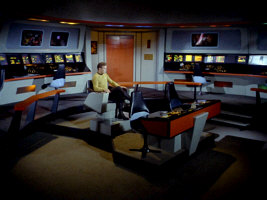
 Empty ship in TOS: "This Side of Paradise"
Empty ship in TOS: "This Side of Paradise"
 Empty and damaged ship in TOS: "The Doomsday Machine"
Empty and damaged ship in TOS: "The Doomsday Machine"
 Ship with dead crew in TOS: "The Omega Glory"
Ship with dead crew in TOS: "The Omega Glory"
 Ship with dead crew TOS: "The Tholian Web"
Ship with dead crew TOS: "The Tholian Web"
 Fake empty ship in TOS: "The Mark of Gideon"
Fake empty ship in TOS: "The Mark of Gideon"TNG
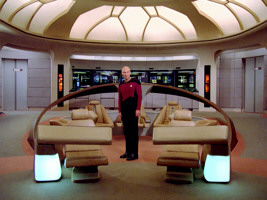
 Empty ship in TNG: "Hide and Q"
Empty ship in TNG: "Hide and Q"
 Empty ship in TNG: "11001001"
Empty ship in TNG: "11001001"
 Fake empty ship in TNG: "Where Silence Has Lease"
Fake empty ship in TNG: "Where Silence Has Lease"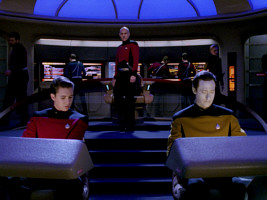
 Dark ship in TNG: "Yesterday's Enterprise"
Dark ship in TNG: "Yesterday's Enterprise"
 Illusory ship in TNG: "Remember Me"
Illusory ship in TNG: "Remember Me"
 Dark ship in TNG: "Disaster"
Dark ship in TNG: "Disaster"
 Illusory ship in TNG: "Birthright I/II"
Illusory ship in TNG: "Birthright I/II"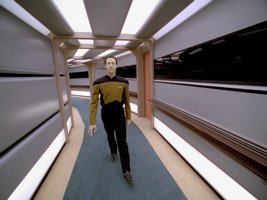
 Illusory ship in TNG: "Phantasms"
Illusory ship in TNG: "Phantasms"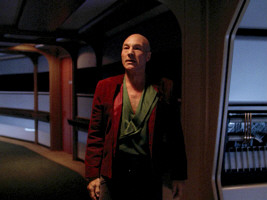
 Dark and empty ship in TNG: "Starship Mine"
Dark and empty ship in TNG: "Starship Mine"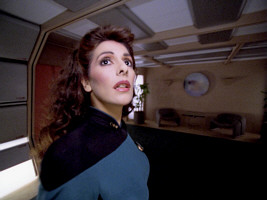
 Illusory ship in TNG: "Dark Page"
Illusory ship in TNG: "Dark Page"
 Dark ship in TNG: "Masks"
Dark ship in TNG: "Masks"
 Dark ship in TNG: "Genesis"
Dark ship in TNG: "Genesis"TNG Movies
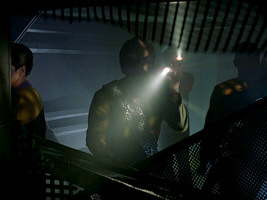
 Dark station in "Star Trek Generations"
Dark station in "Star Trek Generations"
 Dark ship in "Star Trek Generations"
Dark ship in "Star Trek Generations"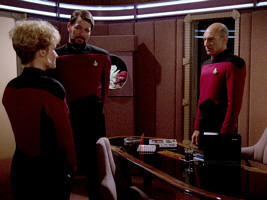
 Bright ship in TNG: "The Best of Both Worlds II"
Bright ship in TNG: "The Best of Both Worlds II"
 Dark ship in "Star Trek Generations"
Dark ship in "Star Trek Generations"
 Bright ship in TNG: "The Offspring"
Bright ship in TNG: "The Offspring"
 Dark ship in "Star Trek Generations"
Dark ship in "Star Trek Generations"
 Bright ship in TNG: "The Best of Both Worlds I"
Bright ship in TNG: "The Best of Both Worlds I"
 Dark ship in "Star Trek: First Contact"
Dark ship in "Star Trek: First Contact"
 Dark ship in "Star Trek Nemesis"
Dark ship in "Star Trek Nemesis"DS9

 Illusory ship in DS9: "Emissary"
Illusory ship in DS9: "Emissary"
 Dark station in DS9: "Civil Defense"
Dark station in DS9: "Civil Defense"
 Illusory station in DS9: "Distant Voices"
Illusory station in DS9: "Distant Voices"
 Dark ship in DS9: "The Adversary"
Dark ship in DS9: "The Adversary"
 Dark ship in DS9: "Starship Down"
Dark ship in DS9: "Starship Down"
 Dark and empty station in DS9: "Empok Nor"
Dark and empty station in DS9: "Empok Nor"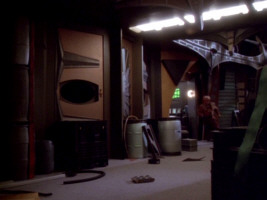
 Dark and empty station DS9: "The Magnificent Ferengi"
Dark and empty station DS9: "The Magnificent Ferengi"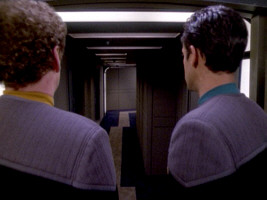
 Illusory ship in DS9: "Extreme Measures"
Illusory ship in DS9: "Extreme Measures"Voyager

 Illusory ship in VOY: "Projections"
Illusory ship in VOY: "Projections"
 Empty ship in VOY: "Macrocosm"
Empty ship in VOY: "Macrocosm"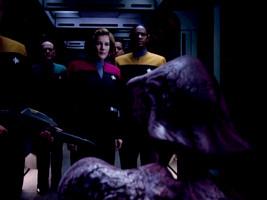
 Dark ship in VOY: "Prey"
Dark ship in VOY: "Prey"
 Dark and damaged ship in VOY: "Year of Hell I/II"
Dark and damaged ship in VOY: "Year of Hell I/II"
 Dark and empty ship in VOY: "One"
Dark and empty ship in VOY: "One"
 Dark ship in VOY: "Night"
Dark ship in VOY: "Night"
 Illusory(?) dark ship in VOY: "The Haunting of Deck Twelve"
Illusory(?) dark ship in VOY: "The Haunting of Deck Twelve"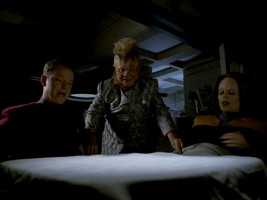
 Dark ship in VOY: "The Void"
Dark ship in VOY: "The Void"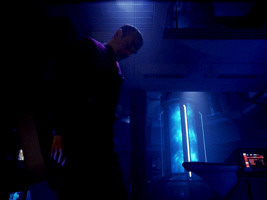
 Dark and empty ship in VOY: "Workforce I"
Dark and empty ship in VOY: "Workforce I"Enterprise

 Dark ship in ENT: "Broken Bow"
Dark ship in ENT: "Broken Bow"
 Dark ship in ENT: "Silent Enemy"
Dark ship in ENT: "Silent Enemy"
 Empty station in ENT: "Dead Stop"
Empty station in ENT: "Dead Stop"
 Illusory ship in ENT: "Doctor's Orders"
Illusory ship in ENT: "Doctor's Orders"
 Dark and damaged ship in ENT: "Damage"
Dark and damaged ship in ENT: "Damage"
 Dark ship in ENT: "Daedalus"
Dark ship in ENT: "Daedalus"
 Dark and empty ship in ENT: "In a Mirror, Darkly I/II"
Dark and empty ship in ENT: "In a Mirror, Darkly I/II"Discovery

 Dark ship in DIS: "Context is for Kings"
Dark ship in DIS: "Context is for Kings"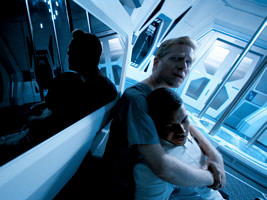
 Illusory dark ship in DIS: "The Wolf Inside"
Illusory dark ship in DIS: "The Wolf Inside"
 Illusory ship in DIS: "Vaulting Ambition"
Illusory ship in DIS: "Vaulting Ambition"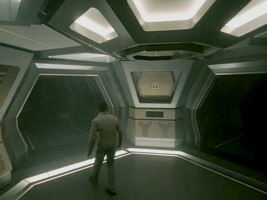
 Empty ship in SHO: "Calypso"
Empty ship in SHO: "Calypso"
 Dark ship in DIS: "Saints of Imperfection"
Dark ship in DIS: "Saints of Imperfection"
 Dark and empty ship in DIS: "Mirrors"
Dark and empty ship in DIS: "Mirrors"Picard

 Illusory dark room in PIC: "Et in Arcadia Ego II"
Illusory dark room in PIC: "Et in Arcadia Ego II"
 Illusory ready room in PIC: "Monsters"
Illusory ready room in PIC: "Monsters"
 Dark interior of the Eleos in PIC: "The Next Generation"
Dark interior of the Eleos in PIC: "The Next Generation"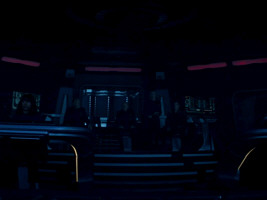
 Pitch dark bridge of the Titan in PIC: "No Win Scenario"
Pitch dark bridge of the Titan in PIC: "No Win Scenario"
 Dark Daystrom Station in PIC: "The Bounty"
Dark Daystrom Station in PIC: "The Bounty"Strange New Worlds
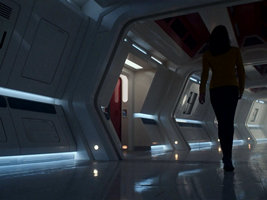
 Dimmed corridor in SNW: "Ghosts of Illyria"
Dimmed corridor in SNW: "Ghosts of Illyria"
 Abandoned sister ship in SNW: "All Those Who Wander"
Abandoned sister ship in SNW: "All Those Who Wander"
 Abandoned sister ship in SNW: "Hegemony"
Abandoned sister ship in SNW: "Hegemony"Lower Decks

 Dark and empty ship in LOW: "Much Ado About Boimler"
Dark and empty ship in LOW: "Much Ado About Boimler"
See Also
The Evolution of the Enterprise-D Bridge - changes to the bridge set over the years
Star Trek Clichés - recurring oddities that deserve to be mentioned, but are not necessarily inconsistent
Credits
All illustrations are sourced from TrekCore, a wonderful resource for all things Star Trek and multimedia! The images are used with their permission.
Fine people on Twitter took on to helping me too, and my thanks go to Sisco, Nav, Larry Nemecek, Danball, Poverlord, HpstLaFontaine, AdamHunault and rndstrofchars for hitting me up with names of episodes. Thanks to Deakin for an expert consultation on cinematography and filming darkness.

















